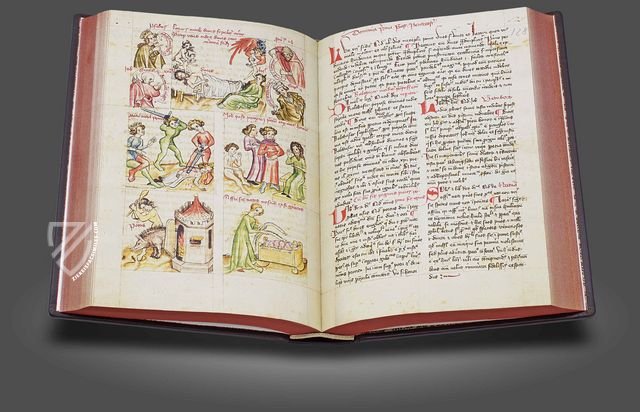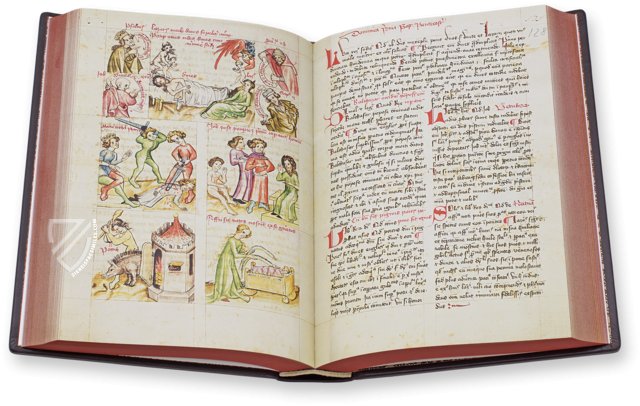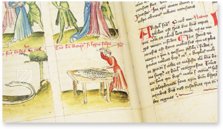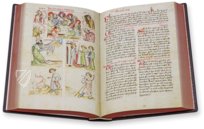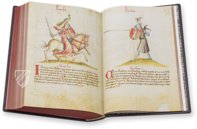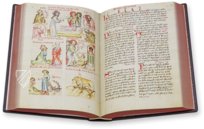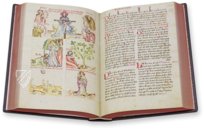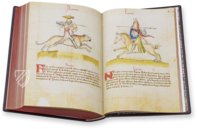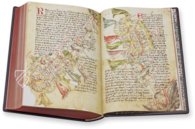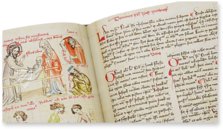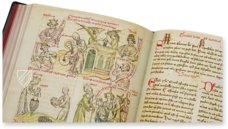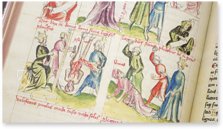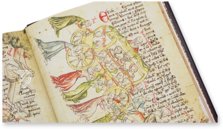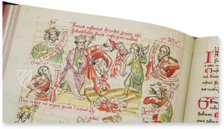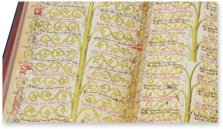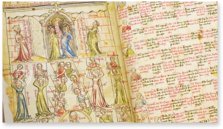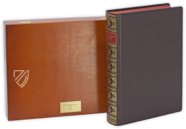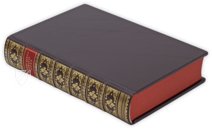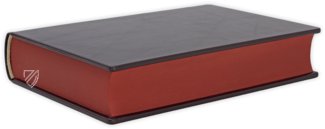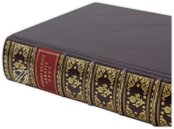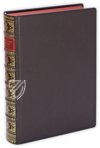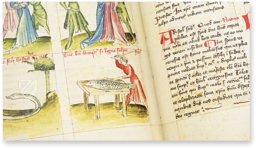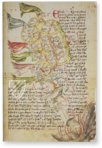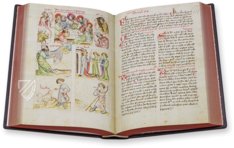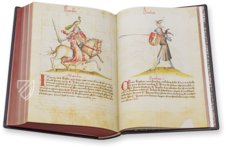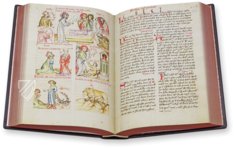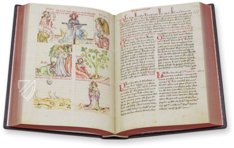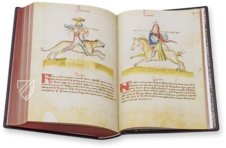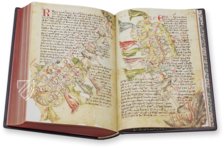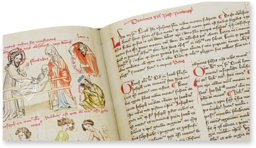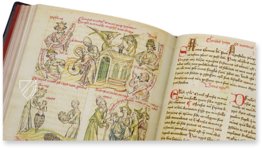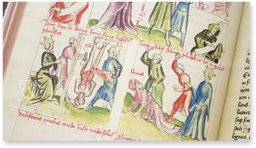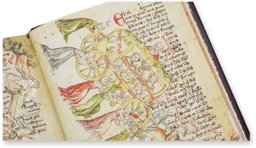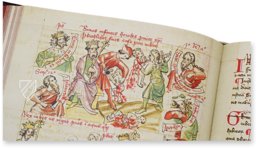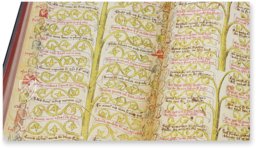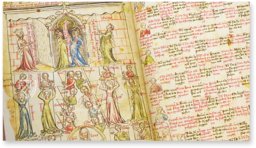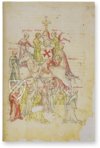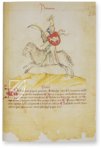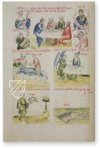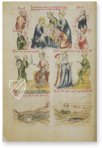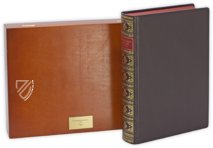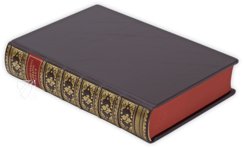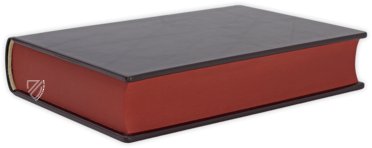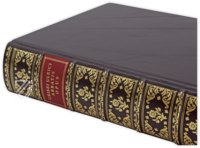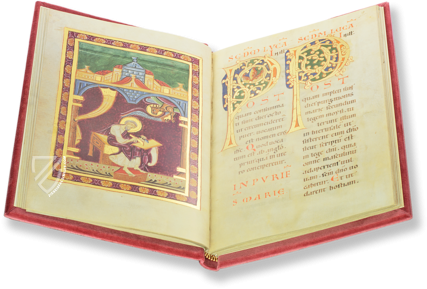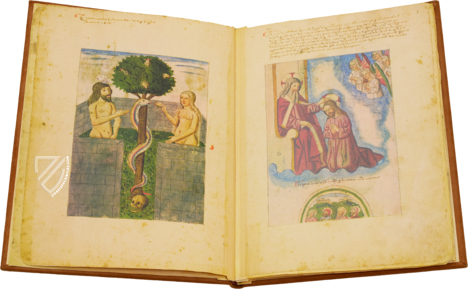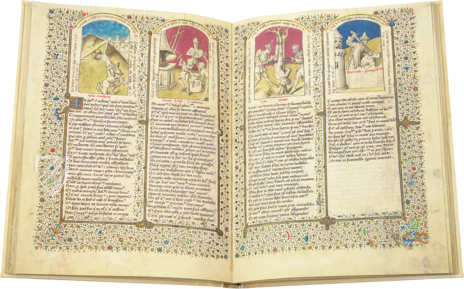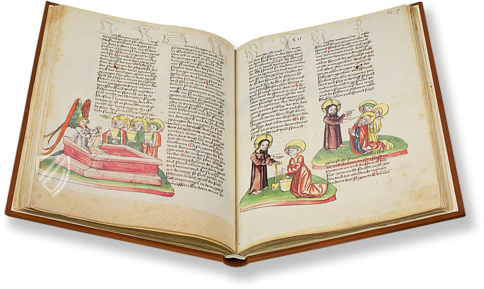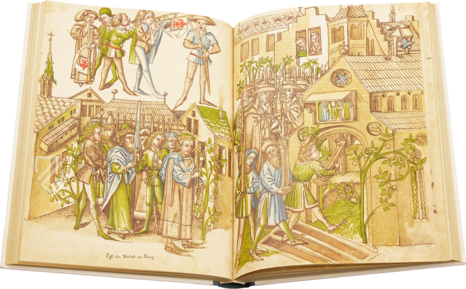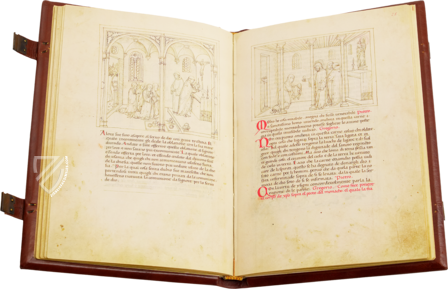Budapest Concordantiae Caritatis
(3,000€ - 7,000€)
The most richly illustrated medieval manuscript in Hungary: the Budapest Concordantiae caritatis by Abbot Ulrich Lilienfeld (ca. 1308–58), who directed Lilienfeld Abbey from 1345–1351. The work is a typological manuscript, i.e. a work that ties the events of the Old and New Testaments to one another as relates to the story of Redemption. Scenes from the Old Testament serve as a model for scenes from the New Testament, which fulfill the prophecy of the former and create a holistic, reciprocally enlightening whole. The specimen at hand represents the most complete manuscript of its kind, comprising 238 typological units arranged in the form of an encyclopedia. The codex’s colophon dates the work to 1413, which was written down by the Viennese scribe Stephanus Lang.
Budapest Concordantiae Caritatis
This is an outstanding work of late-medieval Austrian illumination comprising 1,000+ miniatures from a group of seven talented artists, it is the most richly illuminated manuscript in modern Hungary, and the most complete manuscript of its kind: Budapest Concordantiae caritatis by Abbot Ulrich Lilienfeld (ca. 1308–58). It is a typological manuscript, i.e. a work that ties the events of the Old and New Testaments to one another as relates to the story of Redemption. Scenes from the Old Testament serve as a model for scenes from the New Testament, which fulfill the prophecy of the former and create a holistic, reciprocally enlightening whole. 238 such typographical units are gorgeously presented here in a large, 524-page manuscript measuring 27 x 39 cm and contained within a gilded calfskin binding. This is one of the finest specimens of late medieval illumination from Central Europe to survive to the present and a gem in the history of art and theology.
A Gorgeous Morally Instructive Work
This is an incredibly rich source containing 1,225 biblical scenes, scenes from the lives of saints, and depictions of natural phenomena depicted in 1,000+ miniatures in the form of pen and ink drawings created by a team of seven artists, the most talented of which was connected to the circle of the Master of the Sankt Lambrecht Votive Picture, whose style dominated early–15th century Viennese panel painting. Although working in collaboration with one another, stylistic differences between them are evident, allowing for a glimpse into late-medieval workshop culture. Each of the 238 typographical units assumes the same five-part-form in the codex: the text appears on the right page and the illustrations on the left. The primary scene is found at the top of the page with the two related scenes from the Old Testament below it, while two natural scenes appear at the bottom of the page. Partially written in German, a so-called “picture-catechism”, which depicts virtues and vices fighting one another astride various animals and chariots as well as the Miles Christi (soldier of Christ), rounds out the work. Stephanus Lang, educated at the University of Prague, meant for his work to be an inexhaustible source on the world first created by God and then shaped by man, which was also to be richly illuminated. The Budapest codex clearly fulfills this wish, even if most copies of the manuscript were unadorned copies used by priests as a resource while writing their sermons.
A Coveted Manuscript
Only eight illuminated manuscripts of Lang’s work have survived to the present and the specimen at hand is not only the most complete, but the most refined in terms of artistic quality. Details about the ownership history prior to the 17th century are scarce, but it is known for certain that the splendid manuscript found itself in the possession of Pál Lászlóffy, registrar of the Hungarian Chancellery in Vienna, in 1646. It was acquired by the Pálffy family in 1666 and was part of the library of Bajmóc Castle (modern Bojnice, Slovakia) until 1795, when it passed to the library of the Piarist Order in Pozsony szentgyörgy (modern Svätý Jur, Slovakia). In 1906, the manuscript was sent to the Central Library of the Piarist Order in Budapest, where it remains today. Scholarly interest in the work was reignited in 1979 by the Piarist monk László Papp when he published the first study of the manuscript and it is hoped that the production of the facsimile edition will lead to a thorough analysis of the Budapest Concordantiae caritatis.
Codicology
- Alternative Titles
- Die Budapester Concordantiae Caritatis
- Size / Format
- 524 pages / 39.0 × 27.0 cm
- Origin
- Austria
- Date
- 1413
- Epochs
- Style
- Artist / School
- Ulrich von Lilienfeld
Stephanus Lang (scribe)
Circle of the Master of the Sankt Lambrecht Votive Picture - Previous Owners
- Pál Lászlóffy
Pálffy family at Bajmóc Castle
Library of the Piarist Order in Pozsony szentgyörgy
Budapest Concordantiae Caritatis
Adoration of the Magi
The specimen at hand represents the most complete manuscript of its kind, comprising 238 typological units arranged in the form of an encyclopedia that connect events from the Old and New Testaments to one another as relates to the story of Redemption. Here the typical Adoration of the Magi scene is presented flanked by figures from the Old Testament such as King David, Christ’s ancestor, and the prophet Malachi or "messenger of YHWH". Thus, the promise of the Messiah is fulfilled.
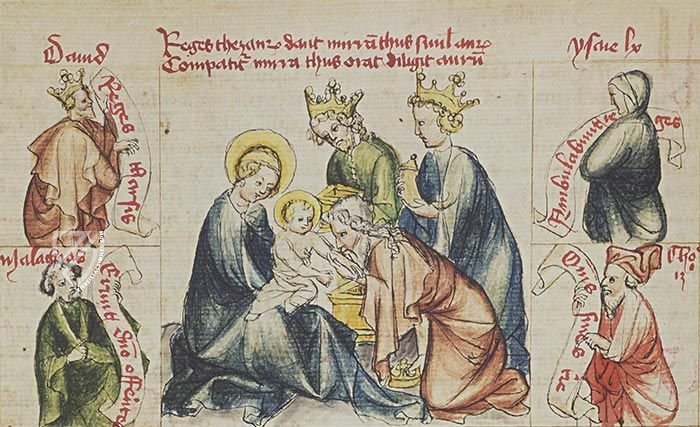
Budapest Concordantiae Caritatis
Tower of Virtues
After addressing various biblical subjects and the lives of saints, the second half of the work turns to Christian morality. Virtues were often personified by female figures during the Middle Ages, and the same is true of these women with long, flowing curls of blonde hair and dresses of green, blue, and red. They are meant to represent the characteristics of an ideal Christian knight.
The knight’s shield and armor are love, his helmet is hope, and his other virtues are self-denial, gentleness, humility, abstinence, love of God, and love of the soul. Four women holding up the horse’s hooves represent the cardinal virtues of truth, cleverness, temperance, and spiritual strength. Labelled with the word anima or “soul”, the cross is exalted above all else.
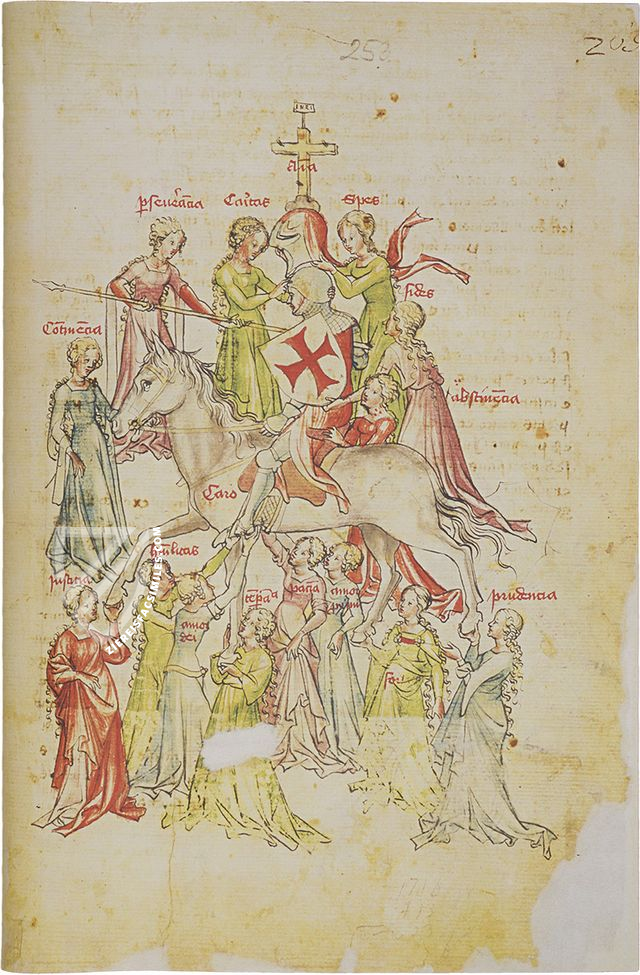
#1 Budapester Concordantiae Caritatis
Language: English
(3,000€ - 7,000€)
- Treatises / Secular Books
- Apocalypses / Beatus
- Astronomy / Astrology
- Bestiaries
- Bibles / Gospels
- Chronicles / History / Law
- Geography / Maps
- Saints' Lives
- Islam / Oriental
- Judaism / Hebrew
- Single Leaf Collections
- Leonardo da Vinci
- Literature / Poetry
- Liturgical Manuscripts
- Medicine / Botany / Alchemy
- Music
- Mythology / Prophecies
- Psalters
- Other Religious Books
- Games / Hunting
- Private Devotion Books
- Other Genres
- Afghanistan
- Armenia
- Austria
- Belgium
- Belize
- Bosnia and Herzegovina
- China
- Colombia
- Costa Rica
- Croatia
- Cyprus
- Czech Republic
- Denmark
- Egypt
- El Salvador
- Ethiopia
- France
- Germany
- Greece
- Guatemala
- Honduras
- Hungary
- India
- Iran
- Iraq
- Israel
- Italy
- Japan
- Jordan
- Kazakhstan
- Kyrgyzstan
- Lebanon
- Liechtenstein
- Luxembourg
- Mexico
- Morocco
- Netherlands
- Palestine
- Panama
- Peru
- Poland
- Portugal
- Romania
- Russia
- Serbia
- Spain
- Sri Lanka
- Sweden
- Switzerland
- Syria
- Tajikistan
- Turkey
- Turkmenistan
- Ukraine
- United Kingdom
- United States
- Uzbekistan
- Vatican City
- A. Oosthoek, van Holkema & Warendorf
- Aboca Museum
- Ajuntament de Valencia
- Akademie Verlag
- Akademische Druck- u. Verlagsanstalt (ADEVA)
- Aldo Ausilio Editore - Bottega d’Erasmo
- Alecto Historical Editions
- Alkuin Verlag
- Almqvist & Wiksell
- Amilcare Pizzi
- Andreas & Andreas Verlagsbuchhandlung
- Archa 90
- Archiv Verlag
- Archivi Edizioni
- Arnold Verlag
- ARS
- Ars Magna
- ArtCodex
- AyN Ediciones
- Azimuth Editions
- Badenia Verlag
- Bärenreiter-Verlag
- Belser Verlag
- Belser Verlag / WK Wertkontor
- Benziger Verlag
- Bernardinum Wydawnictwo
- BiblioGemma
- Biblioteca Apostolica Vaticana (Vaticanstadt, Vaticanstadt)
- Bibliotheca Palatina Faksimile Verlag
- Bibliotheca Rara
- Boydell & Brewer
- Bramante Edizioni
- Bredius Genootschap
- Brepols Publishers
- British Library
- C. Weckesser
- Caixa Catalunya
- Canesi
- CAPSA, Ars Scriptoria
- Caratzas Brothers, Publishers
- Carus Verlag
- Casamassima Libri
- Centrum Cartographie Verlag GmbH
- Chavane Verlag
- Christian Brandstätter Verlag
- Circulo Cientifico
- Club Bibliófilo Versol
- Club du Livre
- CM Editores
- Collegium Graphicum
- Collezione Apocrifa Da Vinci
- Comissão Nacional para as Comemorações dos Descobrimentos Portugueses
- Coron Verlag
- Corvina
- CTHS
- D. S. Brewer
- Damon
- De Agostini/UTET
- De Nederlandsche Boekhandel
- De Schutter
- Deuschle & Stemmle
- Deutscher Verlag für Kunstwissenschaft
- DIAMM
- Droz
- E. Schreiber Graphische Kunstanstalten
- Ediciones Boreal
- Ediciones Grial
- Ediclube
- Edições Inapa
- Edilan
- Editalia
- Edition Deuschle
- Edition Georg Popp
- Edition Leipzig
- Edition Libri Illustri
- Editiones Reales Sitios S. L.
- Éditions de l'Oiseau Lyre
- Editions Medicina Rara
- Editorial Casariego
- Editorial Mintzoa
- Editrice Antenore
- Editrice Velar
- Edizioni Edison
- Egeria, S.L.
- Eikon Editores
- Electa
- Emery Walker Limited
- Enciclopèdia Catalana
- Eos-Verlag
- Ephesus Publishing
- Ernst Battenberg
- Eugrammia Press
- Extraordinary Editions
- Fackelverlag
- Facsimila Art & Edition
- Facsimile Editions Ltd.
- Facsimilia Art & Edition Ebert KG
- Faksimile Verlag
- Feuermann Verlag
- Folger Shakespeare Library
- Franco Cosimo Panini Editore
- Friedrich Wittig Verlag
- Fundación Hullera Vasco-Leonesa
- G. Braziller
- Gabriele Mazzotta Editore
- Gebr. Mann Verlag
- Gesellschaft für graphische Industrie
- Getty Research Institute
- Giovanni Domenico de Rossi
- Giunti Editore
- Graffiti
- Grafica European Center of Fine Arts
- Guido Pressler
- Guillermo Blazquez
- Gustav Kiepenheuer
- H. N. Abrams
- Harrassowitz
- Harvard University Press
- Helikon
- Hendrickson Publishers
- Henning Oppermann
- Herder Verlag
- Hes & De Graaf Publishers
- Hoepli
- Holbein-Verlag
- Houghton Library
- Hugo Schmidt Verlag
- Idion Verlag
- Il Bulino, edizioni d'arte
- ILte
- Imago
- Insel Verlag
- Insel-Verlag Anton Kippenberger
- Instituto de Estudios Altoaragoneses
- Instituto Nacional de Antropología e Historia
- Introligatornia Budnik Jerzy
- Istituto dell'Enciclopedia Italiana - Treccani
- Istituto Ellenico di Studi Bizantini e Postbizantini
- Istituto Geografico De Agostini
- Istituto Poligrafico e Zecca dello Stato
- Italarte Art Establishments
- Jan Thorbecke Verlag
- Johnson Reprint Corporation
- Josef Stocker
- Josef Stocker-Schmid
- Jugoslavija
- Karl W. Hiersemann
- Kasper Straube
- Kaydeda Ediciones
- Kindler Verlag / Coron Verlag
- Kodansha International Ltd.
- Konrad Kölbl Verlag
- Kurt Wolff Verlag
- La Liberia dello Stato
- La Linea Editrice
- La Meta Editore
- Lambert Schneider
- Landeskreditbank Baden-Württemberg
- Leo S. Olschki
- Les Incunables
- Liber Artis
- Library of Congress
- Libreria Musicale Italiana
- Lichtdruck
- Lito Immagine Editore
- Lumen Artis
- Lund Humphries
- M. Moleiro Editor
- Maison des Sciences de l'homme et de la société de Poitiers
- Manuscriptum
- Martinus Nijhoff
- Maruzen-Yushodo Co. Ltd.
- MASA
- Massada Publishers
- McGraw-Hill
- Metropolitan Museum of Art
- Militos
- Millennium Liber
- Müller & Schindler
- Nahar - Stavit
- Nahar and Steimatzky
- National Library of Wales
- Neri Pozza
- Nova Charta
- Oceanum Verlag
- Odeon
- Orbis Mediaevalis
- Orbis Pictus
- Österreichische Staatsdruckerei
- Oxford University Press
- Pageant Books
- Parzellers Buchverlag
- Patrimonio Ediciones
- Pattloch Verlag
- PIAF
- Pieper Verlag
- Plon-Nourrit et cie
- Poligrafiche Bolis
- Presses Universitaires de Strasbourg
- Prestel Verlag
- Princeton University Press
- Prisma Verlag
- Priuli & Verlucca, editori
- Pro Sport Verlag
- Propyläen Verlag
- Pytheas Books
- Quaternio Verlag Luzern
- Reales Sitios
- Recht-Verlag
- Reichert Verlag
- Reichsdruckerei
- Reprint Verlag
- Riehn & Reusch
- Roberto Vattori Editore
- Rosenkilde and Bagger
- Roxburghe Club
- Salerno Editrice
- Saltellus Press
- Sandoz
- Sarajevo Svjetlost
- Schöck ArtPrint Kft.
- Schulsinger Brothers
- Scolar Press
- Scrinium
- Scripta Maneant
- Scriptorium
- Shazar
- Siloé, arte y bibliofilia
- SISMEL - Edizioni del Galluzzo
- Sociedad Mexicana de Antropología
- Société des Bibliophiles & Iconophiles de Belgique
- Soncin Publishing
- Sorli Ediciones
- Stainer and Bell
- Studer
- Styria Verlag
- Sumptibus Pragopress
- Szegedi Tudomànyegyetem
- Taberna Libraria
- Tarshish Books
- Taschen
- Tempus Libri
- Testimonio Compañía Editorial
- Thames and Hudson
- The Clear Vue Publishing Partnership Limited
- The Facsimile Codex
- The Folio Society
- The Marquess of Normanby
- The Richard III and Yorkist History Trust
- Tip.Le.Co
- TouchArt
- TREC Publishing House
- TRI Publishing Co.
- Trident Editore
- Tuliba Collection
- Typis Regiae Officinae Polygraphicae
- Union Verlag Berlin
- Universidad de Granada
- University of California Press
- University of Chicago Press
- Urs Graf
- Vallecchi
- Van Wijnen
- VCH, Acta Humaniora
- VDI Verlag
- VEB Deutscher Verlag für Musik
- Verlag Anton Pustet / Andreas Verlag
- Verlag Bibliophile Drucke Josef Stocker
- Verlag der Münchner Drucke
- Verlag für Regionalgeschichte
- Verlag Styria
- Vicent Garcia Editores
- W. Turnowski Ltd.
- W. Turnowsky
- Waanders Printers
- Wiener Mechitharisten-Congregation (Wien, Österreich)
- Wissenschaftliche Buchgesellschaft
- Wissenschaftliche Verlagsgesellschaft
- Wydawnictwo Dolnoslaskie
- Xuntanza Editorial
- Zakład Narodowy
- Zollikofer AG

